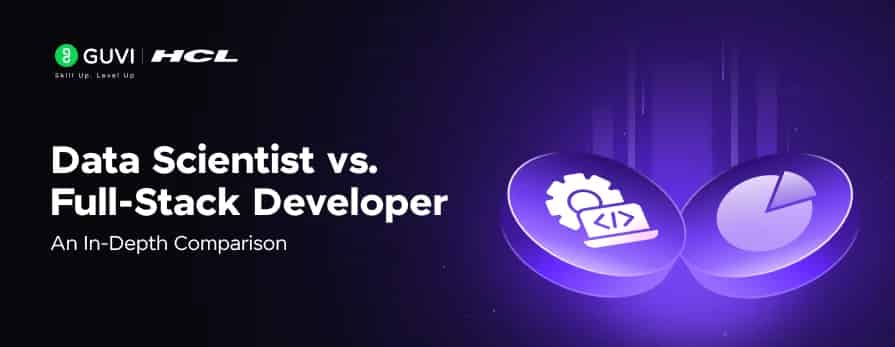
Data Scientist vs. Full-Stack Developer: A Comparison Guide
Oct 08, 2025 5 Min Read 5293 Views
(Last Updated)
The tech world offers two very different yet exciting career paths: Data Scientist and Full-Stack Developer. Both roles are in high demand, but they involve distinct skills and day-to-day work.
In this article, we’ll compare these roles across several dimensions: definitions and responsibilities, technical skills, education and learning paths, career opportunities and demand, salaries and outlook, work culture, and real-world impact.
So, without further ado, let us get started!
Table of contents
- Definition and Core Responsibilities
- Data Scientist
- Full-Stack Developer
- Required Technical Skills and Tools
- Data Scientist skills:
- Full-Stack Developer skills:
- Educational and Learning Paths
- Data Scientist learning path:
- Full-Stack Developer learning path:
- Career Opportunities and Industry Demand
- Data Science demand:
- Full-Stack Developer demand:
- Average Salary and Job Outlook
- Data Scientist salary:
- Full-Stack Developer salary:
- Work Culture and Collaboration
- Data Scientist work culture:
- Full-Stack Developer work culture:
- Data Scientist or Full Stack Developer: Which Path Fits You?
- Conclusion
- FAQs
- Which is better: Data Scientist or Full-Stack Developer?
- Is data science harder than full-stack development?
- Are the roles interchangeable?
- Do I need a degree to become a full-stack developer or data scientist?
- Which role offers a higher salary?
Definition and Core Responsibilities
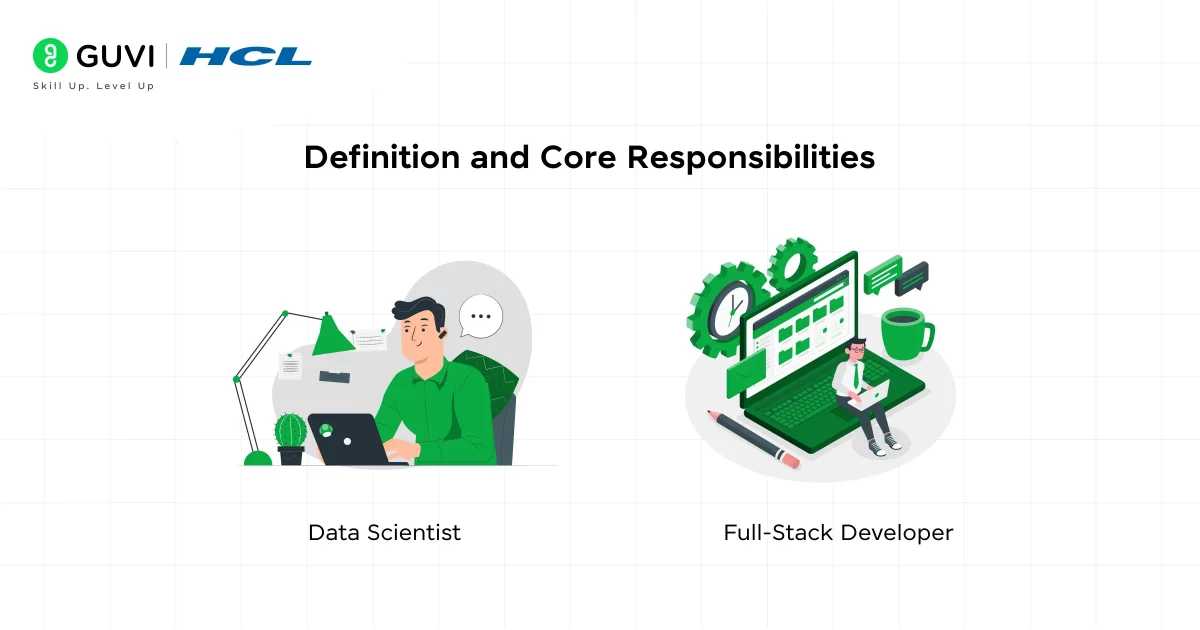
Data Scientist
A data scientist uses statistical and computational techniques to extract insights from data. They’re the ones who interpret the stories hidden within large datasets. Typical responsibilities include:
- Analyzing data and finding patterns. For example, identifying trends in customer behavior or operational data.
- Building predictive models and algorithms. Using machine learning to forecast outcomes or automate decisions.
- Data preparation and cleaning. Organizing and preprocessing raw data to make it usable.
- Data tools and visualization. Employing tools like Python, R, SQL, Tableau, or Power BI to analyze and present data.
- Communicating insights. Explaining findings and recommendations to stakeholders, often through reports or dashboards.
If you want to know how to become a Data Scientist, read the blog – A Complete Guide to Becoming a Data Scientist in 6 Months
Full-Stack Developer
A full-stack developer is a software engineer who works on both the front-end and back-end of web applications. This means they can design user interfaces and manage server-side logic and databases. Key responsibilities include:
- Designing and building web applications. Handling everything from the user interface to the server and database (end-to-end).
- Front-end development. Writing HTML, CSS, and JavaScript (and frameworks like React or Angular) to create interactive user interfaces.
- Back-end development. Implementing server-side code with languages like Python, Java, PHP, or Node.js, and managing databases (e.g., MySQL, MongoDB).
- Testing and debugging. Ensuring both front-end and back-end code work together smoothly, and fixing issues.
- Collaborating with other teams. Working closely with designers, product managers, and QA to deliver features.
If you want to know how to become a Full Stack Developer, read the blog – Full Stack Developer: Learn the Fastest Way to Become One
Required Technical Skills and Tools
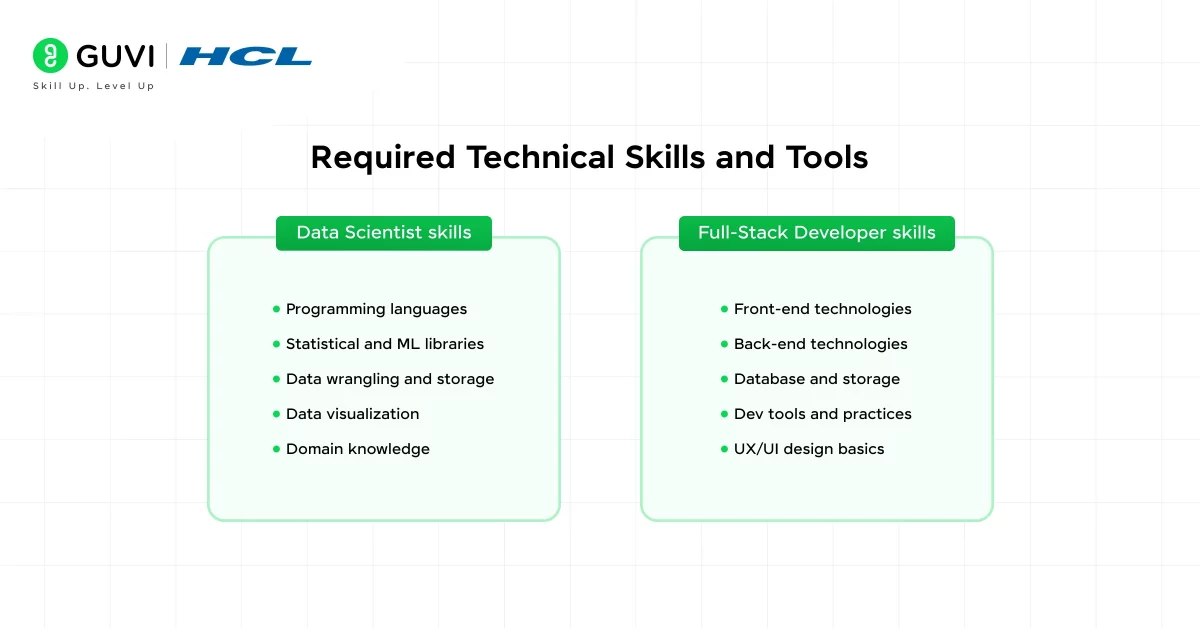
While both roles involve programming, the specific skills differ. Below are the main technical skills and tools for each role:
Data Scientist skills:
- Programming languages: Common languages include Python and R for analysis, as well as SQL for databases. Some also use SAS or Scala.
- Statistical and ML libraries: Familiarity with libraries like scikit-learn, TensorFlow, pandas, and NumPy for building models.
- Data wrangling and storage: Experience with data tools like Pandas, Hadoop, Spark, or HDFS for handling large datasets.
- Data visualization: Tools like Tableau, Power BI, matplotlib, or seaborn to create charts and dashboards.
- Domain knowledge: Understanding of statistics, probability, and sometimes specialized domains (e.g. finance, healthcare).
Full-Stack Developer skills:
- Front-end technologies: HTML, CSS, JavaScript, and frameworks/libraries like React, Angular, or Vue.js. They create layouts, styles, and interactive elements.
- Back-end technologies: Server-side languages/frameworks such as Node.js, Python (Django/Flask), Java (Spring), or PHP. Knowledge of algorithms, RESTful APIs, and cloud services (e.g. AWS, Azure) is important.
- Database and storage: Experience with SQL databases (MySQL, PostgreSQL, SQL Server) and/or NoSQL databases (MongoDB, Cassandra).
- Dev tools and practices: Familiarity with version control (Git), package managers, build tools, and ideally containerization (Docker) or DevOps basics.
- UX/UI design basics: While not required to be a designer, knowing UI principles helps collaborate with designers.
In short, they focus on data analysis and modeling, using statistical and ML tools, while full-stack developers focus on software engineering across the whole web stack (both client and server).
Educational and Learning Paths
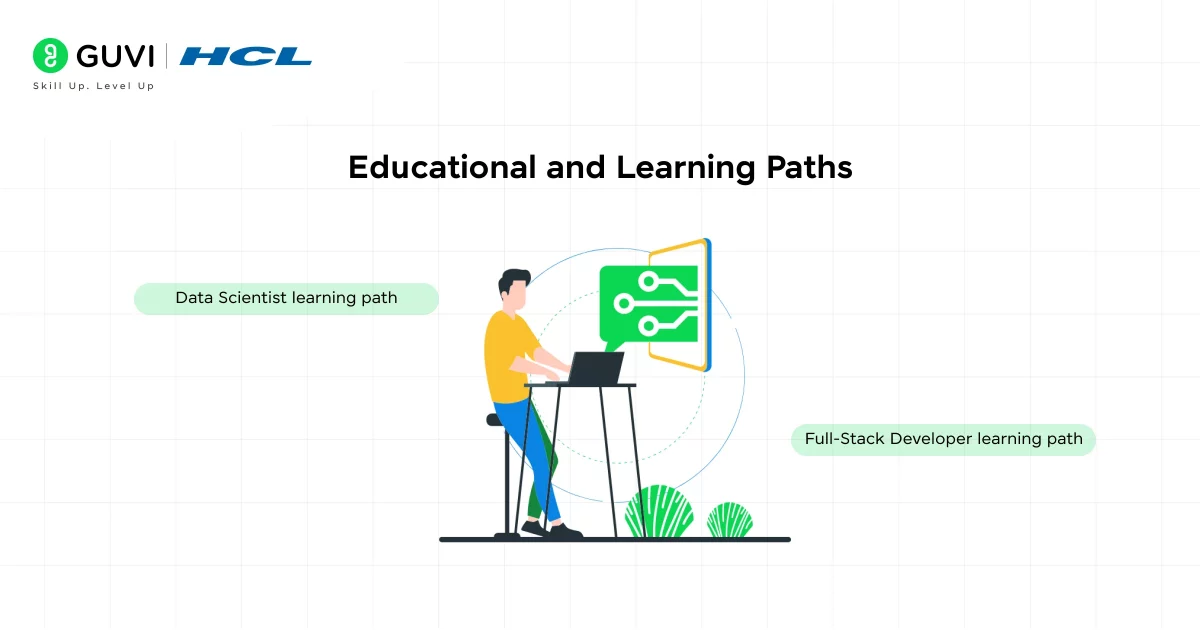
Both careers value strong technical foundations, but the paths to get there can vary.
Data Scientist learning path:
Many data scientists start with a formal degree in a quantitative field (computer science, statistics, engineering, etc.). About 51% of data scientists have a bachelor’s degree, and 34% have a master’s.
Advanced degrees (master’s or PhDs) are common, especially in more research-oriented roles. However, data science is also accessible through other routes: online courses, bootcamps, and professional certificates are popular.
Many learners build portfolios by doing projects (Kaggle competitions, capstones) to demonstrate skills.
If you want to learn more about Data Science and become a Data Scientist through a structured program that starts from scratch, consider enrolling in HCL GUVI’s IIT-M Pravartak Certified Data Science Course, which empowers you with the skills and guidance for a successful and rewarding data science career!
Full-Stack Developer learning path:
Full-stack developers often have a degree in computer science or software engineering, but that’s not strictly required. Many developers are self-taught or come from coding bootcamps focusing on web development.
Education (formal or informal) typically includes computer science fundamentals plus hands-on coding practice. Bootcamps and online courses (on Coursera, Udacity, edX, etc.) can teach front-end and back-end frameworks. The key is to build a portfolio of web projects to show employers.
In both fields, lifelong learning is vital. For data science, this might mean learning new ML techniques or data tools. For full-stack, it means keeping up with evolving frameworks and languages.
Alternatively, if you want to learn more about Full-stack development and become a full-stack developer, consider enrolling in HCL GUVI’s IIT-M Pravartak certified Full Stack Development Course with AI Tools, which provides you with all the resources and guidance to have a successful full-stack career!
Career Opportunities and Industry Demand
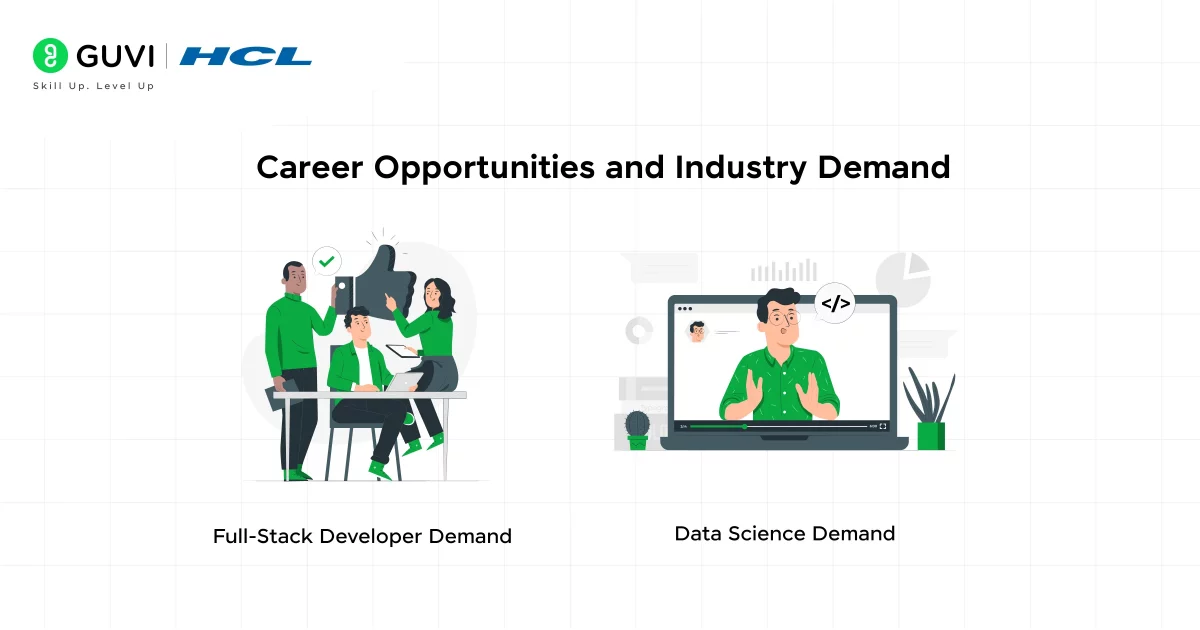
The demand for both data scientists and full-stack developers is strong, but trends differ by industry and growth rate:
Data Science demand:
Data science has become essential in many sectors – from tech and finance to healthcare and retail. Companies use data scientists to optimize processes, personalize services, and drive strategy.
As a result, data science roles are very much in demand. The US Bureau of Labor Statistics (BLS) projects about 36% job growth for data scientists between 2023 and 2033, far above the average for all occupations.
This rapid growth reflects the expanding need for analytics and AI. Data science jobs include roles like Data Scientist, Machine Learning Engineer, Data Engineer, and Business Intelligence Analyst, each with strong prospects.
Full-Stack Developer demand:
Full-stack developers are highly sought after because of their versatility. Startups and established companies alike value engineers who can handle end-to-end development. Software and web development jobs (which include full-stack roles) also have a positive outlook.
The BLS expects about 17% growth for software developers (including full-stack) from 2023 to 2033. That’s well above average and indicates steady demand. Nearly every industry needs web and mobile applications, so full-stack skills are widely applicable.
Overall, both paths offer robust opportunities. If you enjoy dynamic work and coding, full-stack gives many options in tech companies. If you’re drawn to analytics and data-driven decision-making, data science opens doors in both tech and non-tech industries.
Average Salary and Job Outlook
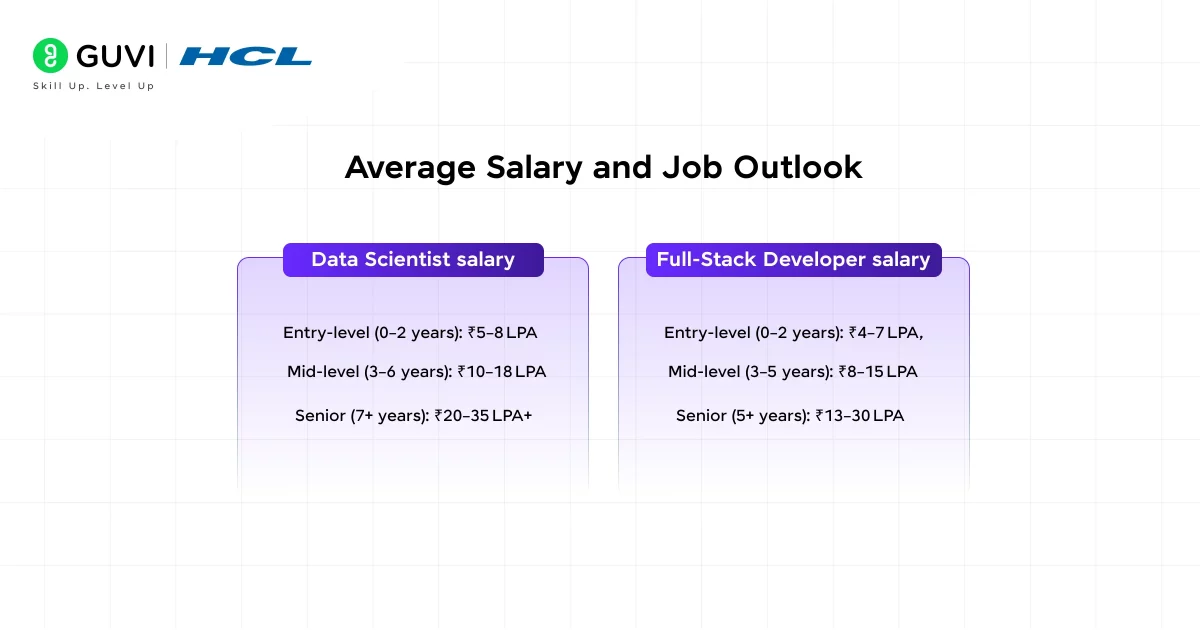
Salaries for these careers are generally high, reflecting the specialized skills required. Keep in mind that actual pay varies by location, experience, and industry:
Data Scientist salary:
Data scientists earn a premium salary. More experienced data scientists and those in major tech hubs can earn significantly more.
- Entry-level (0–2 years): ₹5–8 LPA (₹6–8 L for freshers typically)
- Mid-level (3–6 years): ₹10–18 LPA, with domain or specialization roles commanding higher figures
- Senior (7+ years): ₹20–35 LPA+; in top tech or product startups, packages may exceed ₹40–50 LPA
Full-Stack Developer salary:
Full-stack developers also command strong salaries. In practice, entry-level full-stack developers might start lower, while senior engineers or those at big tech firms can far exceed six figures.
- Entry-level (0–2 years): ₹4–7 LPA, typically around ₹5 LPA for freshers.
- Mid-level (3–5 years): ₹8–15 LPA, depending on project complexity and tech stack expertise.
- Senior (5+ years): ₹13–30 LPA in startups or MNCs, with some highly experienced developers earning above ₹30 LPA.
Both careers tend to offer competitive compensation. In many companies, data scientists sometimes earn slightly more on average, but top developers are also well-paid.
Work Culture and Collaboration
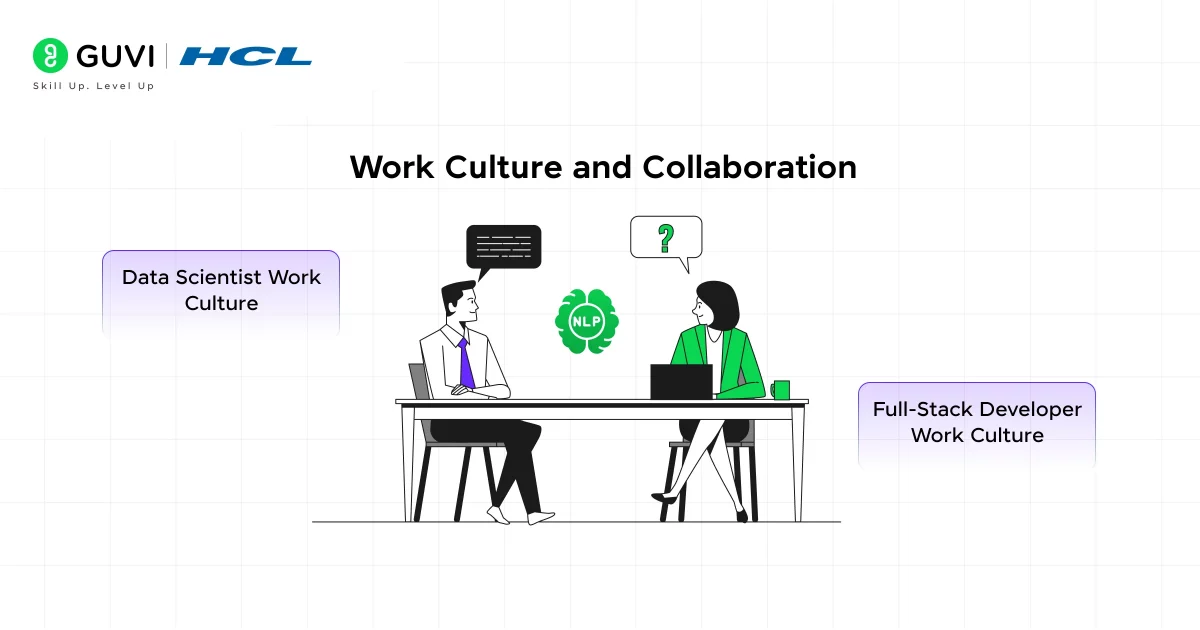
The day-to-day work environment for data scientists and full-stack developers can differ:
Data Scientist work culture:
Data scientists often work in interdisciplinary teams. They collaborate with business stakeholders (product managers, executives) to understand problems and with engineers to deploy models.
Their work can be project-based and research-like: exploring data, prototyping models, then iterating. This role requires strong problem-solving and analytical skills, as one must formulate questions and test hypotheses with data.
Depending on the company, there may be some flexibility, but deadlines around product releases or business decisions can demand intense focus periods.
Full-Stack Developer work culture:
Full-stack developers typically work in software teams using agile or Scrum processes. They constantly communicate with other developers (front-end, back-end, DevOps), designers, and QA.
Teamwork is crucial – each part of the application must fit together. According to Scaler, full-stack devs have cultures focused on “teamwork, adaptability, and continuous learning”. Sprints and frequent releases mean regular coding cycles and reviews.
Work-life balance is generally stable, but deadlines (especially before launches) can lead to overtime.
Data Scientist or Full Stack Developer: Which Path Fits You?
Consider which of the following statements resonates more with you. Choose A if you lean toward Data Science, or B if you lean toward Full-Stack Development.
- I enjoy working with data to find insights and patterns (A). ── I enjoy writing code to create features and user interfaces (B).
- I’m excited by concepts like machine learning, statistics, and AI (A). ── I’m excited by web technologies, JavaScript frameworks, and end-to-end programming (B).
- I prefer solving open-ended problems where analysis and interpretation are key (A). ── I prefer building concrete applications and seeing a product run end-to-end (B).
- I would rather present findings in charts, reports, or models (A). ── I would rather build a working app or website (B).
- I enjoy learning tools like Python, SQL, and TensorFlow (A). ── I enjoy learning HTML/CSS, JavaScript, and database frameworks (B).
If most of your answers are A, you might be more aligned with Data Science. If most are B, Full-Stack Development may suit you better. Of course, many skills overlap, and neither path is “easy” or “hard”, it’s about your interests and strengths.
In everyday life, both roles are at work behind the scenes. When you use a ride-sharing app, full-stack developers create the app and server infrastructure, while data scientists analyze usage patterns to set pricing or suggest routes. Both roles collaborate to deliver the final product and experience.
Conclusion
In conclusion, Data Scientists and Full-Stack Developers both enjoy strong career prospects and play crucial roles in technology, but they satisfy different interests: Both paths require strong coding skills, continual learning, and collaboration, but the day-to-day work differs.
Ultimately, both careers are dynamic and rewarding. Whichever you choose, focus on building a strong portfolio, staying curious, and collaborating well with others. The tech industry needs talented people in both data science and software development, so choose the one that excites you most, and you’re likely to find success.
FAQs
1. Which is better: Data Scientist or Full-Stack Developer?
There’s no “better” choice; it depends on your interests and career goals. If you’re passionate about extracting insights from data and modeling, data science is ideal. If you enjoy building web apps end-to-end and seeing instant results, full-stack development is more rewarding.
2. Is data science harder than full-stack development?
They both come with challenges: data science demands strong statistics and mathematics, while full-stack requires mastery over diverse programming languages and frameworks. Choose the one that aligns with your strengths and learning preferences, not based on perceived difficulty.
3. Are the roles interchangeable?
No, they serve distinct purposes: data scientists analyze and predict using data, whereas full-stack developers design and implement software solutions. A hybrid role exists, but specialization is still key for deep expertise.
4. Do I need a degree to become a full-stack developer or data scientist?
A formal degree (like CS or STEM) can help, especially for data science roles, but it’s not mandatory. Many professionals enter either field through bootcamps, online courses, and strong portfolios showcasing real projects.
5. Which role offers a higher salary?
Data scientists and full-stack developers both command competitive salaries, influenced by location, experience, and industry. In India, data science averages ₹14 LPA vs ₹8.5 LPA for full-stack; in the U.S., both roles range between $90 K–$125 K+ depending on seniority..
















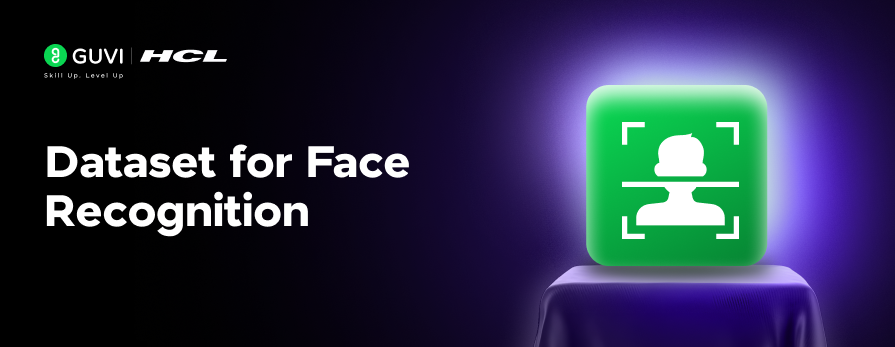
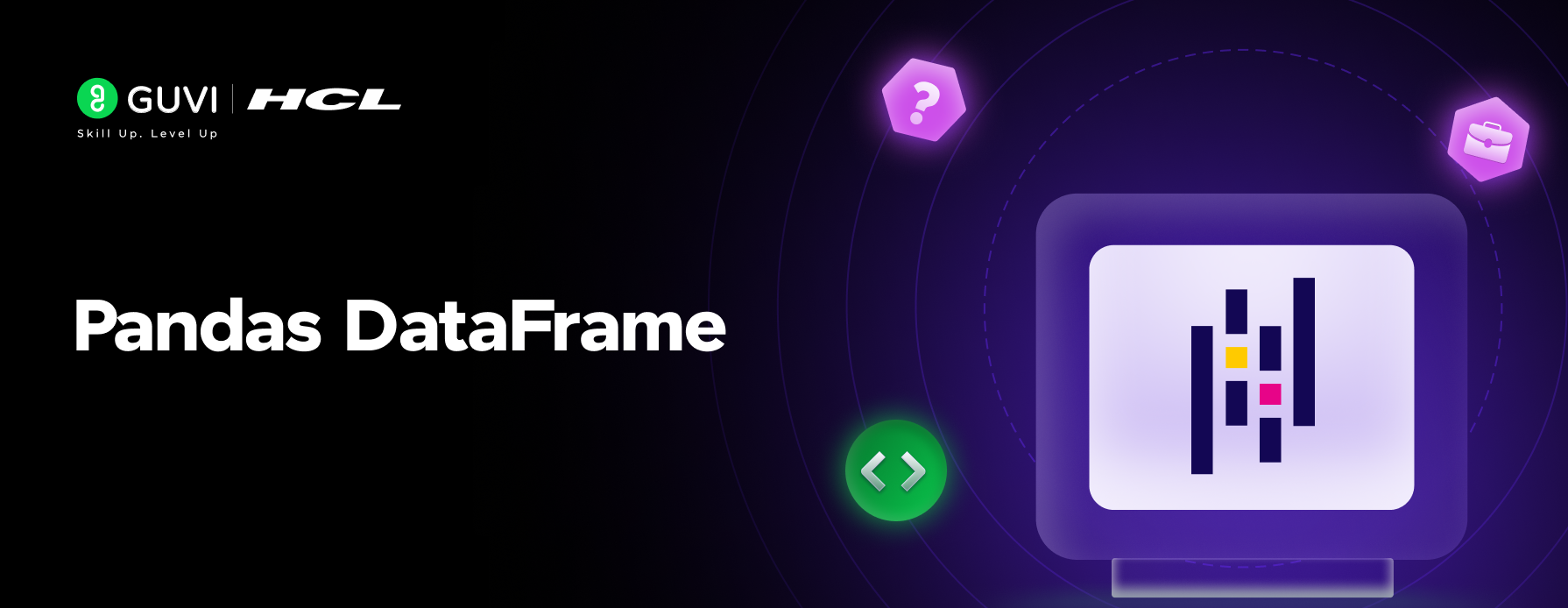
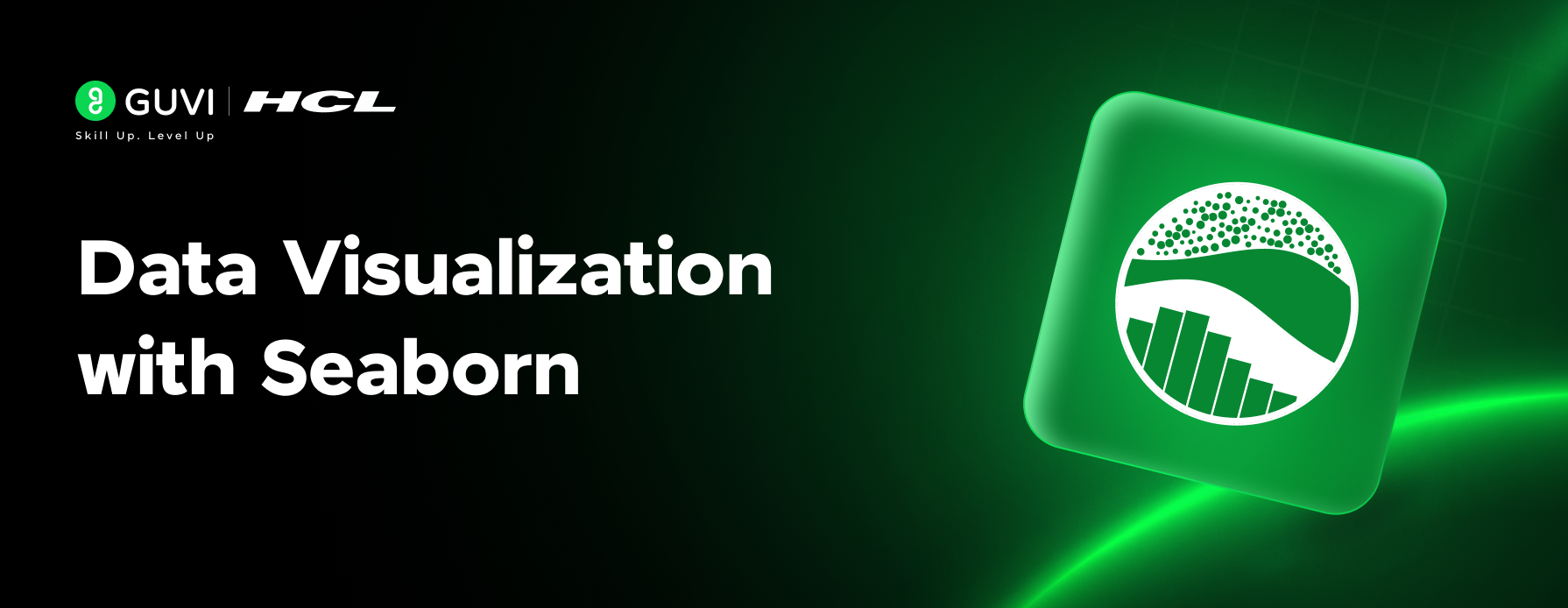
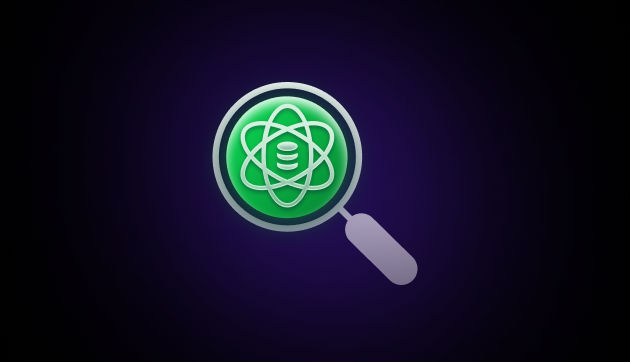
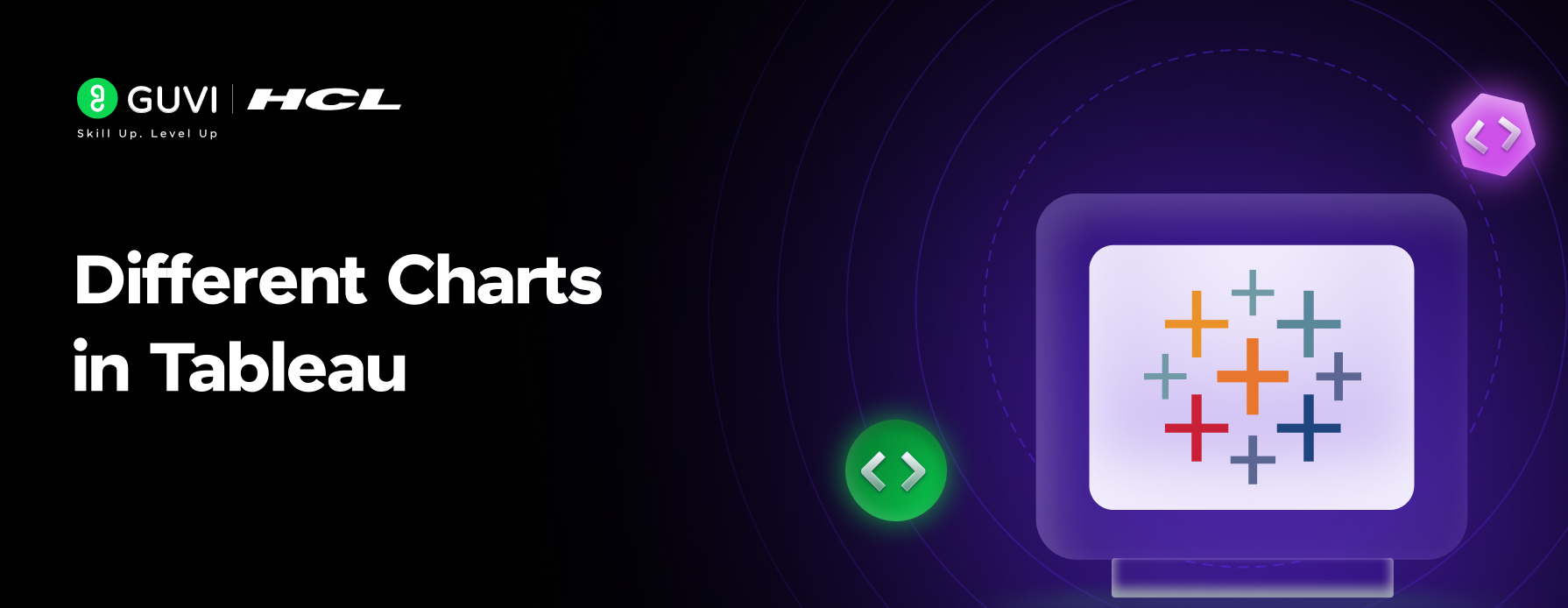

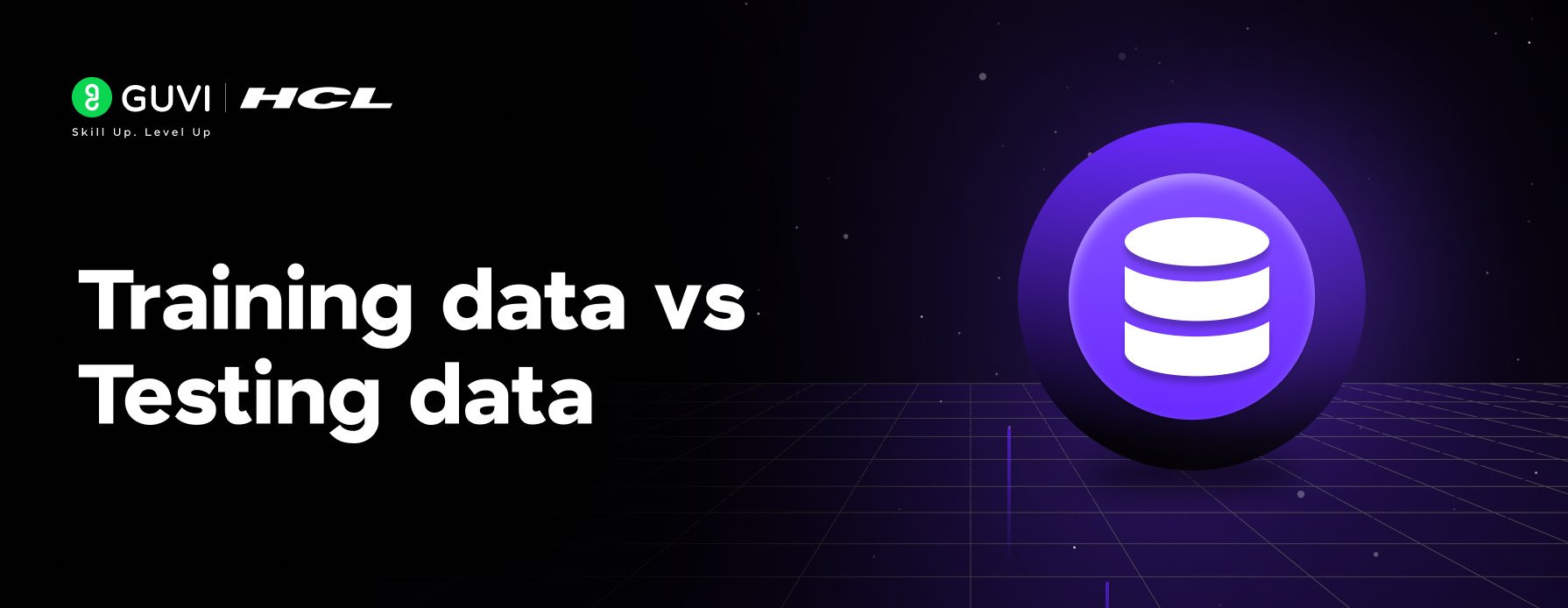






Did you enjoy this article?